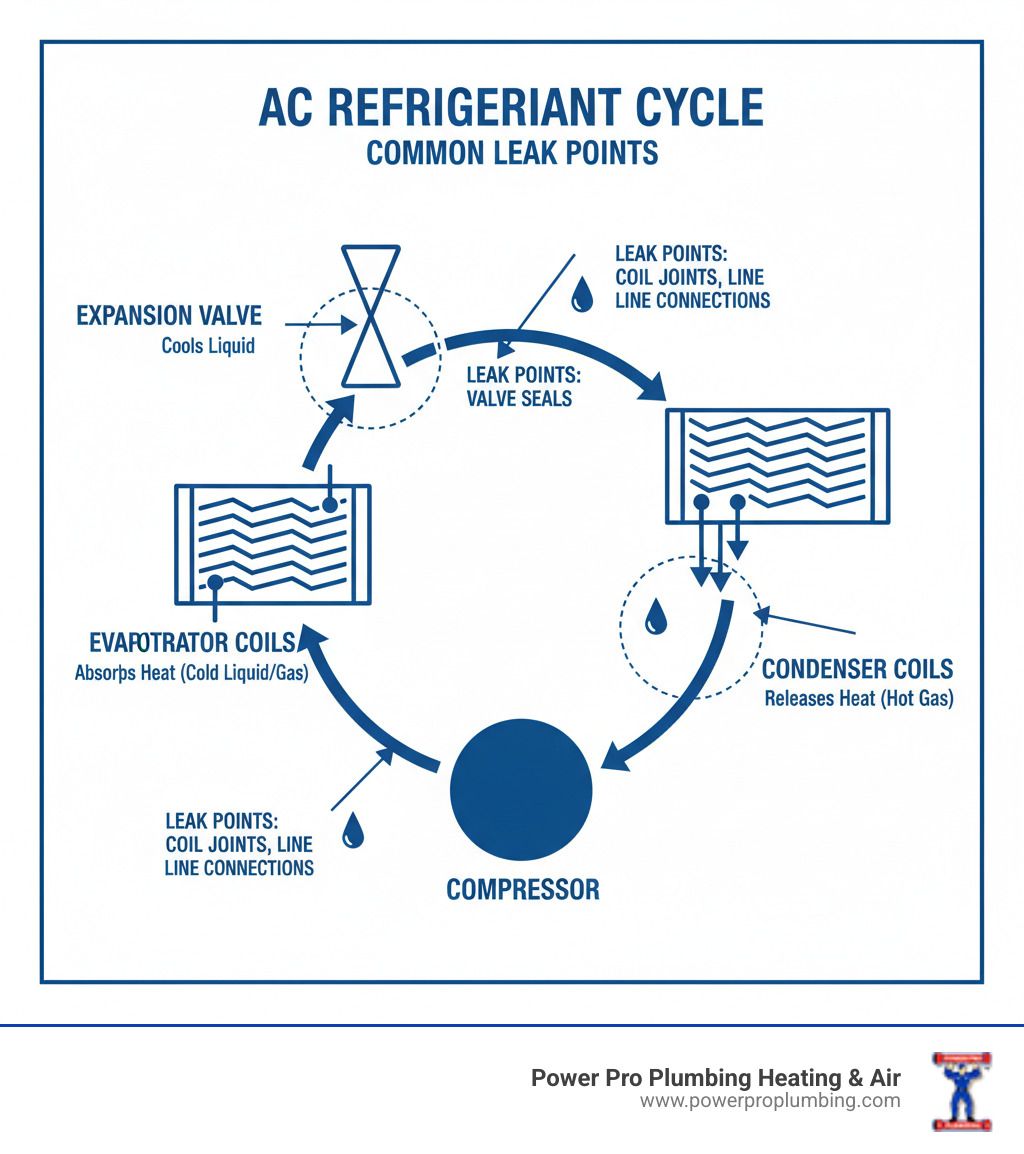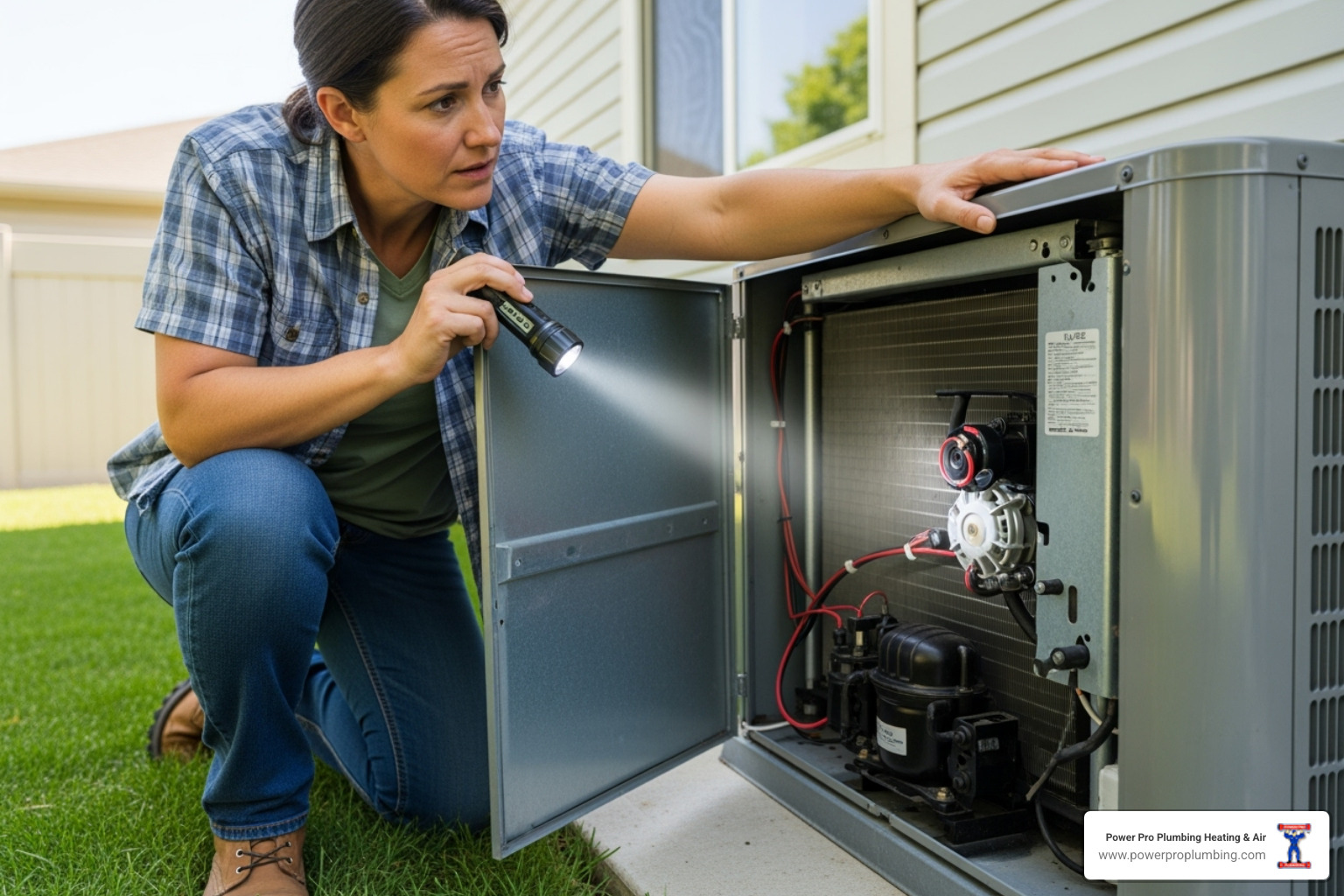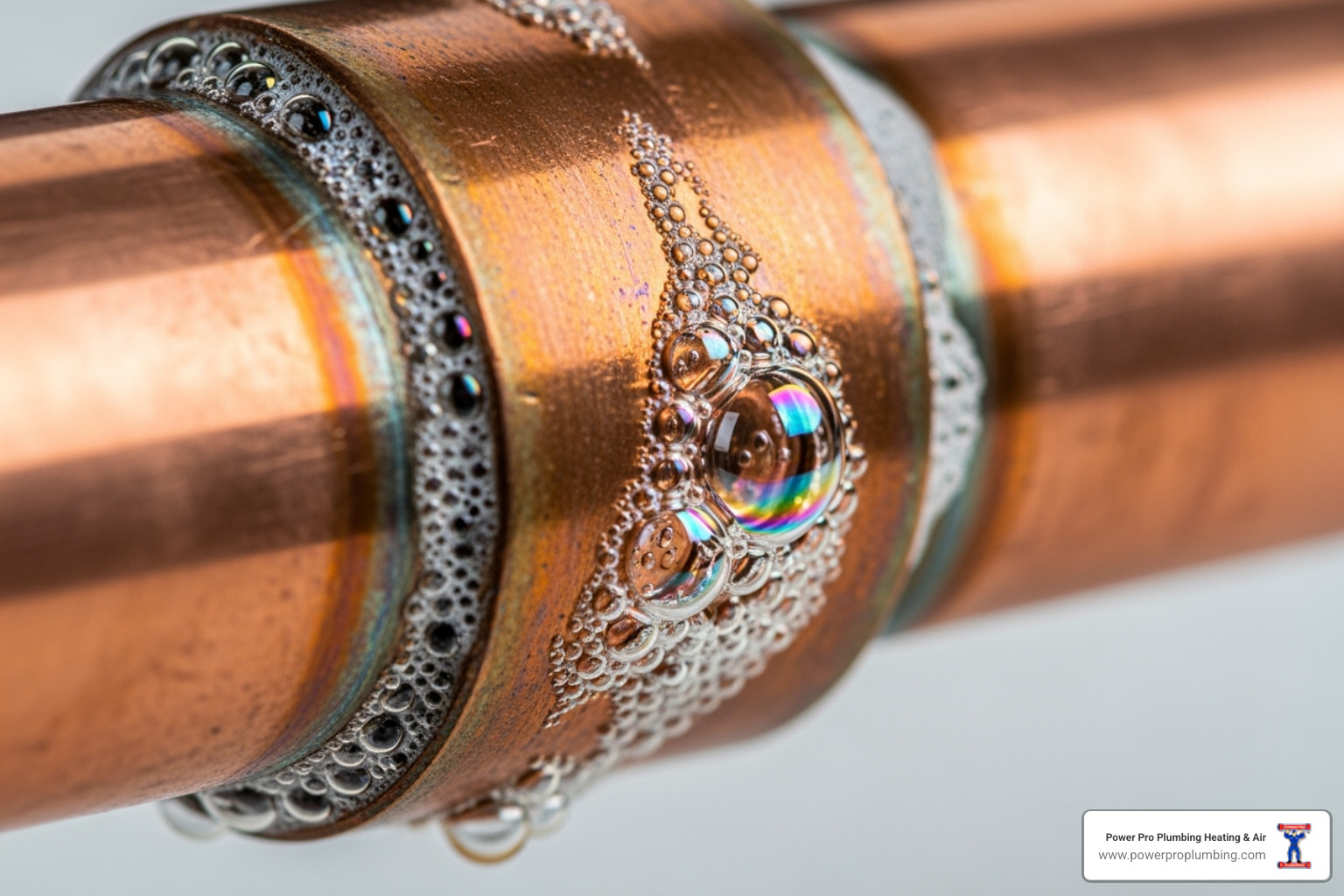
Why Knowing How to Detect Air Conditioner Leak Matters for Your Home
How to detect air conditioner leak starts with recognizing key warning signs and using simple testing methods:
- Check for warm air blowing from vents when the AC is running
- Look for ice buildup on refrigerant lines or evaporator coils
- Listen for hissing or bubbling sounds near the indoor or outdoor unit
- Inspect for oily residue around pipe connections and fittings
- Perform a soapy water test by spraying joints and watching for bubbles
- Monitor your energy bills for unexplained increases
- Call a certified HVAC technician for electronic detection or UV dye testing
In Southern California's scorching summers, your AC works overtime. A refrigerant leak can cause poor performance, high energy bills, and system damage. Ice on the evaporator coils is a key sign of a leak. Running an AC with low refrigerant can damage the compressor, leading to expensive repairs. Fortunately, early warning signs are easy to spot, and knowing how to detect an air conditioner leak can save you money and protect your family from refrigerant exposure.
As Daniel Rodriguez, a licensed HVAC professional, I've seen countless refrigerant leaks in Southern California. Understanding how to detect these problems early is crucial. It protects your comfort and your wallet, which is why I'm sharing these reliable methods for homeowners.

Common Signs of an Air Conditioner Refrigerant Leak
Your air conditioner has ways of telling you when something's wrong. When learning how to detect air conditioner leak issues, recognizing the warning signs early can save you from expensive repairs and keep your home comfortable.
The most noticeable sign is warm air blowing from your vents. If you get air that's barely cool, your AC is probably low on refrigerant and can't absorb heat from your home effectively.
You might also notice your energy bills creeping up without explanation. A refrigerant leak forces your air conditioner to work overtime, running longer to reach your thermostat's setting. This extra effort shows up on your monthly electric bill.
Another common sign is ice buildup on the evaporator coils or refrigerant lines. When refrigerant pressure drops too low, the coils get abnormally cold, causing moisture in the air to freeze on contact. This ice blocks airflow and can cause serious damage to your unit.

Listen carefully to your AC unit. Hissing or bubbling sounds near the indoor or outdoor unit often signal refrigerant escaping through a crack or hole. Hissing usually means refrigerant is spraying out under pressure, while bubbling can indicate it's mixing with moisture or oil.
If your AC seems to run constantly, those longer cooling cycles are a red flag. Your system is struggling to compensate for insufficient refrigerant.
Don't overlook increased indoor humidity. A sticky, clammy feeling in your home—even when the AC is running—tells you the system can't properly dehumidify the air due to low refrigerant.
Finally, check for oily residue or dark stains near pipe connections. Refrigerant circulates with lubricating oil, and when it leaks, it often carries some oil with it. These oily spots are visual evidence of a leak.
Spotting these signs early makes all the difference. For more information, check our blog on Common AC Repair Issues. The U.S. Department of Energy also offers guidance on common air conditioner problems. Recognizing these signs prepares you to take the next step.
How to Detect an Air Conditioner Leak: DIY Methods
Once you've spotted warning signs, you can investigate further with some straightforward DIY methods. These checks can help confirm suspicions about how to detect air conditioner leak problems and provide valuable information before calling a professional.
Before starting, a word on safety: Refrigerant requires careful handling by trained professionals. These DIY methods are for detection only, not repair. If you confirm a leak, you must call a certified HVAC technician to handle the fix safely and correctly.

How to perform a visual inspection for AC leaks
A visual inspection is the first step in any leak hunt. It costs nothing and can reveal a lot about your system's condition.
Start by turning off the AC at the thermostat and the circuit breaker for safety. Then, locate the copper refrigerant lines connecting the indoor and outdoor units—a thicker, insulated suction line and a thinner liquid line.
Now, play detective. Look for oily stains on refrigerant lines or dark residue around pipe fittings. Refrigerant circulates with oil, so it leaves greasy marks when it escapes. Pay close attention to joints, valves, and connections, as these are common leak spots. The filter/dryer tube on the outdoor unit is another prime location.
While inspecting, check for physical damage to the lines or coils. A leak can be caused by something rubbing against a line, corrosion, or accidental damage from lawn equipment. Checking connections on indoor and outdoor units and looking for obvious physical damage provides a complete picture.
How to detect an air conditioner leak with the soapy water test
The soapy water test is a simple, cheap, and effective way to find larger leaks. You'll need a spray bottle, liquid dish soap, and water.
Mix a generous amount of soap with lukewarm water in the spray bottle and shake it well to create a bubbly solution. With the AC system still off, spray the solution on any suspicious spots, such as joints, connections, and areas with oily residue.
Now, watch closely. If there's a leak, the escaping refrigerant will create large, distinctive bubbles at the leak point, similar to a child's bubble wand. A leak rate of about 1 x 10^-3 mbar∙l/s will create roughly one bubble per second.

However, the soapy water test has limitations. It's great for bigger leaks but may not detect very small ones. If you don't see bubbles but still suspect a problem (like warm air or high energy bills), it's time to call a certified HVAC professional. They have specialized equipment to find even the tiniest leaks that DIY methods miss.
Professional Methods for Detecting AC Leaks
While DIY methods can identify larger leaks, many refrigerant leaks are tiny and hidden. This is where professional expertise and specialized equipment are essential. The U.S. Department of Energy recommends professional technicians for A/C repairs because refrigerants require careful handling and finding small leaks demands advanced tools.
Our certified technicians are trained to handle refrigerants safely and find even the smallest leaks. When you need to know how to detect air conditioner leak issues with precision, professional methods are the answer. For a thorough diagnosis, learn more about our AC Diagnostic Service.
Electronic Leak Detectors
Electronic leak detectors, or "sniffers," are highly sensitive handheld devices that find tiny refrigerant leaks DIY methods miss. They detect minute traces of refrigerant gas in the air.
Here's how "sniffers" work: A technician moves the detector's probe along refrigerant lines, joints, and coils. The device samples the air and is designed to detect refrigerant gas by sensing its unique chemical compounds.
When the detector finds refrigerant, it emits an audible alarm, typically beeps that increase in frequency as the probe nears the leak. This allows our technicians to pinpoint the exact location of the leak with high accuracy.
The main advantage of electronic leak detectors is their high sensitivity for pinpointing small leaks. Professional-grade detectors can find leaks far smaller than anything visible or detectable with a soapy water test. This precision allows us to fix leaks before they become major problems, saving you money and keeping your system efficient.
UV Dye Leak Detection
UV dye leak detection is another powerful method, especially for frustrating leaks hidden inside coils or in hard-to-reach areas.
The process begins by injecting fluorescent dye into the AC system's refrigerant circuit. This safe dye mixes with the refrigerant and circulates with refrigerant throughout the system.
If there's a leak, the escaping refrigerant carries the dye with it. After the dye has circulated, our technician uses a UV black light and special goggles. When we shine the light on the AC components, any escaped dye will be glowing at the leak source, making even tiny leaks clearly visible.
UV dye detection is particularly effective for hard-to-find or vibration leaks. It's useful for locating leaks in concealed evaporator coils, condenser coils, and other components where visual inspection is difficult. For intermittent leaks caused by system vibrations, UV dye is often the most reliable method.
Nitrogen Pressure Test
The nitrogen pressure test is a key diagnostic tool used to confirm if a significant leak exists, especially when a system has lost most of its refrigerant. It's an initial step before pinpointing the leak's location.
Our technician recovers any remaining refrigerant and then pressurizes the system with inert nitrogen, which is safe for the environment and your AC. The technician then monitors specialized pressure gauges.
If the pressure drops, it confirms a leak exists somewhere in the system. This test is reliable for detecting moderate to large leaks.
However, the nitrogen pressure test has an important limitation: it confirms a leak is present but generally does not locate the leak's exact position. It tells us there's a problem, but not where. After confirming a leak with this test, our technicians use electronic detectors or UV dye to find the precise location for repair. The nitrogen test is mainly for initial testing of systems with significant leaks.
What to Do Next and How to Prevent Future Leaks
Finding an AC leak is just the beginning. The next steps are vital for protecting your system, and it's equally important to prevent future leaks. Promptly addressing leaks and implementing preventative measures will ensure your AC runs reliably for years. Learn more about keeping your AC in top shape with the Benefits of Routine AC Repair.
Steps to Take if You Suspect a Leak
If you notice signs of a leak, the first and most critical step is to turn off the AC system immediately. Running an AC with low refrigerant can damage the compressor, leading to costly repairs. Turning it off prevents further strain on the system.
Next, avoid DIY repair attempts. Refrigerant is a potentially dangerous substance. Inhaling its fumes can cause refrigerant poisoning, leading to serious health issues. Only certified technicians with proper safety gear should handle refrigerants.
Once you suspect a leak, call a certified HVAC professional. Our team at Power Pro Plumbing Heating & Air has the tools and expertise to safely repair refrigerant leaks. We serve the greater Los Angeles area, including Long Beach and Cerritos. For service in your area, visit our AC Repair Long Beach Cerritos CA page. We're here to get your system running safely again.
Preventing Future Refrigerant Leaks
Prevention is always better than a cure. Most refrigerant leaks are preventable with proper care.
Schedule annual professional maintenance. This is the most important preventative step. Like a car's oil change, it catches small problems before they become expensive ones. Technicians can spot minor corrosion, loose connections, or wear, extending your system's lifespan and efficiency.
Keep coils and fins clean. Dirty coils force the system to work harder, which puts extra strain on components and can accelerate wear and corrosion. Keep your outdoor unit free from debris and have your indoor coils professionally cleaned during maintenance visits.
Ensuring proper installation is crucial. Many leaks are traced back to improper installation, like poorly tightened connections. Always choose a reputable, licensed professional for installation or replacement to prevent future headaches.
Finally, checking for corrosion on lines should be part of your routine. Periodically look at the copper refrigerant lines when the unit is off. Green or black discoloration can indicate corrosion, which weakens the metal. This is common in coastal areas with salt air. Catching this early allows for preventative action before a leak develops.
By following these tips and understanding how to detect air conditioner leak problems early, you can protect your investment and avoid emergency repairs.
Frequently Asked Questions about AC Leaks
Navigating AC repairs can be overwhelming, especially with technical issues like refrigerant leaks. Here are answers to some of the most common questions we hear from homeowners in the Los Angeles area.
What are the primary causes of air conditioner refrigerant leaks?
Refrigerant leaks usually develop gradually over time. Understanding the causes can help you catch problems early.
- Corrosion of metal parts is a common culprit. Exposure to moisture and salt air can cause tiny pinhole leaks in the copper coils and lines.
- Normal wear and tear over time is another factor. Constant vibrations from the AC unit can loosen connections or cause parts to rub against each other, eventually leading to a leak.
- Physical damage to the unit or lines is often preventable. Refrigerant lines can be punctured by lawnmowers or damaged during landscaping. Keeping the area around your outdoor unit clear is important.
- Factory defects or improper installation can cause issues from the start. A flawed component or poorly sealed connection can lead to an early leak, which is why choosing a reputable HVAC company is so important.
Can I just add more refrigerant to my AC?
While it seems like a simple solution, the answer is no. Simply adding more refrigerant is not a fix.
Your AC is a closed-loop system, meaning refrigerant circulates without being used up. If your system is low on refrigerant, it's because there is a leak. Adding more refrigerant, or "topping off," is a temporary fix that allows more of this regulated substance to escape into the atmosphere.
The leak must be repaired first. Otherwise, you'll be paying for another top-off soon without solving the root problem. Due to environmental concerns, refrigerants are regulated, and only a qualified technician can safely repair the leak and recharge the system correctly.
Is a refrigerant leak dangerous?
Yes, a refrigerant leak poses dangers to your health, the environment, and your finances.
- Health Risks: Refrigerant poisoning from inhaling concentrated fumes can cause dizziness, respiratory issues, and even an irregular heartbeat. This is why refrigerant handling should be left to certified professionals.
- Environmental Damage: Many refrigerants are potent greenhouse gases that contribute to climate change when they leak into the atmosphere. This is why their handling is strictly regulated.
- Financial Cost: The most immediate danger to your wallet is that running an AC with low refrigerant can destroy the compressor. The compressor is the heart of your AC, and without enough refrigerant for cooling and lubrication, it overheats and fails. Replacing a compressor is one of the most expensive AC repairs, sometimes making it more practical to replace the entire outdoor unit.
Understanding how to detect air conditioner leak issues early is crucial to protect your health, the environment, and your wallet from catastrophic system damage.
Stay Cool and Safe: Trust the Professionals
Learning how to detect air conditioner leak signs is a smart move for any homeowner. Recognizing issues like warm air, ice on coils, hissing sounds, or oily residue helps protect your investment and comfort. Catching a leak early can prevent a minor issue from becoming a major expense.
While DIY methods like a visual inspection or soapy water test can help confirm your suspicions, repairing a refrigerant leak is not a DIY project. Refrigerants are chemicals that require certified knowledge and specialized equipment to handle safely. This is where professional expertise is non-negotiable.
At Power Pro Plumbing Heating & Air, we serve families across the greater Los Angeles area and understand how critical a working AC is to your comfort. Our certified technicians are equipped with the latest detection tools and have the hands-on experience to fix leaks right the first time, ensuring your system runs efficiently.
Don't let a refrigerant leak disrupt your comfort or lead to high energy bills. Early detection and professional repair are key to avoiding costly compressor damage. For expert and safe leak detection and repair in the Los Angeles area, contact our certified technicians for leak detection services today. We're here to help you stay cool and worry-free.

